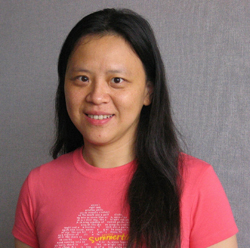Dr. Yi Sun
The ScienceDaily article Functioning Neurons From Human Embryonic Stem Cells Produced said
“Previously, the system to grow and isolate neurons was very messy and it was unknown whether those neurons were functioning,” Yi Sun said. “We’re excited because we have been able to purify so many more neurons out of the cell culture and they were, surprisingly, healthy enough to form synapses. These cells will be excellent for doing gene expression studies and biochemical and protein analyses.”
Sun’s method prodded human embryonic stem cells to differentiate into neural stem cells, the cells that give rise to neurons. When the time was right, Sun’s team added protein growth factors into the cell culture that stopped the neural stem cells from self-renewing and prodded them into differentiating into neurons.
To isolate the cells, Sun and her team added an enzyme that digests a sort of protein matrix that holds cells in culture together. The neurons could then be separated from the neural stem cells that had not yet differentiated, a sort of chemical round-up that isolated the neurons. The cells were then put into a cell strainer that allowed passage through of the isolated neurons.
The large number of pure neurons produced will allow Sun and her team to study their biological form and structure, the genes they express, the development of synapses and the electric and chemical communication activities within the synapse network.
Yi Sun, Ph.D. is Associate Academic Director of the UCLA Institute
for Stem Cell Biology
and Medicine, and
Associate Professor in both the Department of
Psychiatry and
Biobehavioral Sciences and the Department of Molecular and Medical
Pharmacology where she is in charge of the Sun Lab. Yi earned her Ph.D. in Neurosciences at Case Western
Reserve University
and did postdoctoral training in molecular developmental neuroscience
at Harvard Medical School prior to her recruitment to
UCLA.
Yi studies molecular mechanisms underlying cell fate specification,
proliferation, and differentiation of neural stem cells in mammals
including humans. She is particularly interested in alterations in the
transcriptional program via DNA methylation related epigenetic
mechanisms during stem cell differentiation. In addition, her
laboratory is also in the process of cultivating and genetically
modifying human and mouse embryonic stem cells so that they can direct
the differentiation process of the cells to produce various highly pure
subtype neurons and glia in large quantity. This approach will allow
not only the production of cells for use in repairing the injured
nervous system through cell-replacement therapy but also building human
neuronal culture models for a number of neurological diseases that can
be used for studying disease etiology and drug screening.
She coauthored
DNA methylation-related chromatin remodeling in activity-dependent
BDNF
gene regulation,
A positive autoregulatory loop of Jak-STAT signaling controls the
onset
of astrogliogenesis,
Decatenation checkpoint deficiency in stem and progenitor
cells,
The divergent DSL ligand Dll3 does not activate Notch signaling but
cell autonomously attenuates signaling induced by other DSL
ligands,
To learn better, keep the HAT on,
Coupling of cell migration with neurogenesis by proneural bHLH
factors,
and
A critical role for DNA end-joining proteins in both lymphogenesis
and
neurogenesis.





